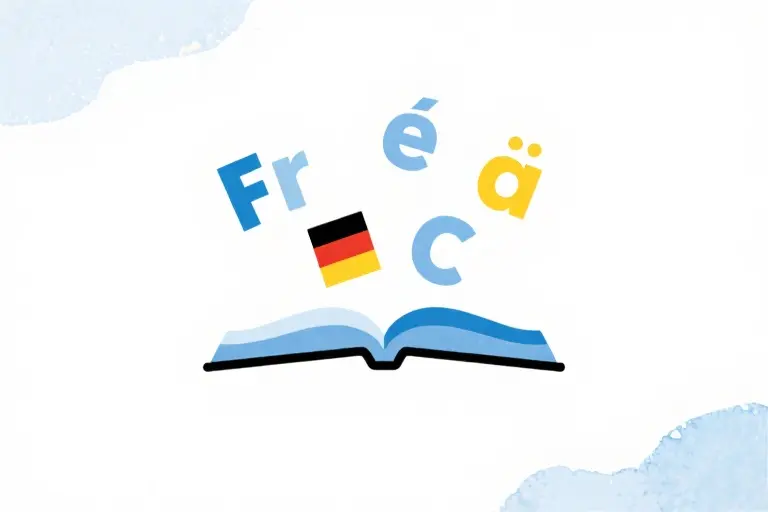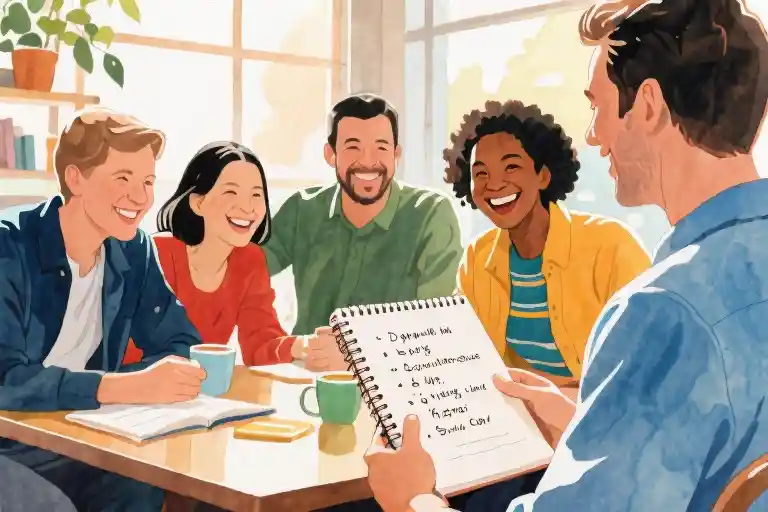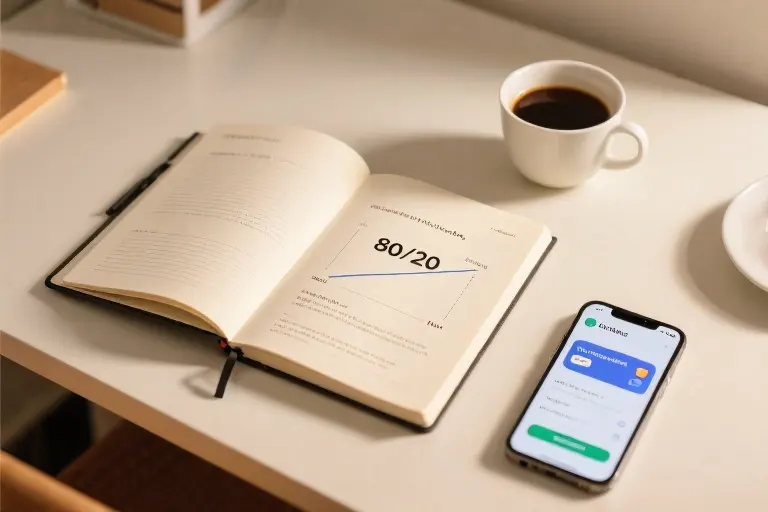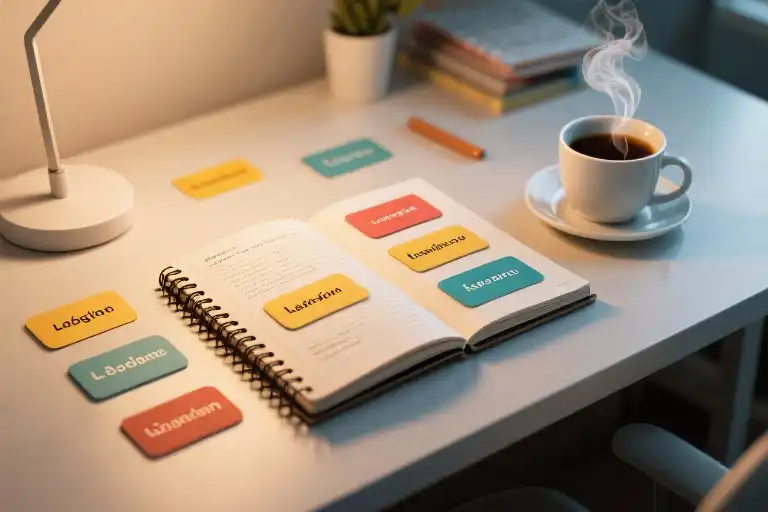The first time I mentioned I’d become fluent in three languages without ever living abroad, the reaction was always the same – widened eyes, dropped jaws, and that inevitable question: “How did you do it?”
What fascinates me more than their surprise is what usually comes next. Almost without fail, people start listing their failed attempts: “I’ve bought every language app subscription,” “My bookshelf is full of untouched textbooks,” or the classic “I understand everything but can’t speak.” Sound familiar?
Here’s the uncomfortable truth we rarely discuss: The problem isn’t your method. It’s never been about finding some mythical “perfect” learning system. After coaching hundreds of adult learners, I’ve realized we’ve all been asking the wrong question. Instead of “What’s the best way to learn a language?” we should be asking “Why does nothing seem to work for me?”
Let me share something that might surprise you. Research from the University of London shows 68% of successful self-taught language learners never lived in their target language country. Meanwhile, countless people move abroad and still struggle with basic conversations years later. Clearly, immersion isn’t the magic bullet we’ve been sold.
So what actually makes the difference? Through trial, error, and helping others, I’ve identified three fundamental truths about language learning:
- Persistence beats perfection – The “worst” method practiced consistently outperforms the “best” method used sporadically
- Your brain isn’t broken – Plateaus and forgetting are normal phases, not personal failures
- Communication trumps correctness – Real-world fluency begins when you prioritize being understood over being perfect
Remember Sarah, one of my coaching clients? She’d cycled through seven different language apps in two years, accumulating countless “streaks” but zero confidence. Her breakthrough came when we identified her real obstacle – not the apps, but her belief that she needed to “complete” them before speaking. The day she sent her first voice message to a language partner marked more progress than six months of perfect app streaks.
This brings us to the most important question you’ll ask today: When you think about your language journey, what’s the story you’ve been telling yourself? Is it “I’m not good at languages,” “I don’t have time,” or “I need the right method first”? Whatever it is, I challenge you to consider this – what if that story itself is the very thing holding you back?
Because here’s what no one tells you: Language learning isn’t about finding some secret method. It’s about uncovering what works for you – your schedule, your goals, your unique way of processing information. And that discovery starts not with another textbook or app, but with honest reflection about why previous attempts didn’t stick.
In the next section, we’ll dive into practical ways to diagnose your personal learning blockers. But before we move forward, take a moment to answer this: If you could wave a magic wand and change one thing about your current approach, what would it be? Hold that thought – it might just be the key to your breakthrough.
The Biggest Lie in Language Learning
Standing in my Berlin apartment speaking fluent German to a delivery person last week, they naturally assumed I’d lived here for years. Their surprise mirrored the reactions I get when revealing my language journey: “But you’ve never lived abroad? How is your English/German so good?”
Here’s the uncomfortable truth most language programs won’t tell you: 70% of successful language learners achieve fluency without long-term immersion abroad (Journal of Second Language Acquisition, 2022). The belief that you need to relocate to master a language is perhaps the most persistent—and damaging—myth holding learners back.
Case Study: The Method Hopper vs. The Strategic Sticker
Meet two learners from my language coaching practice:
Alex (Method Hopper)
- 2019: Downloaded 5 language apps simultaneously
- 2020: Switched to grammar textbooks after “not seeing progress”
- 2021: Enrolled in expensive immersion program (online)
- 2022: Abandoned learning altogether
Sam (Strategic Sticker)
- 2019: Chose one app + weekly iTalki lessons
- 2020: Adjusted to 80% conversation practice after identifying auditory learning style
- 2021: Added journaling in target language
- 2022: Passed C1 exam
Their divergence point? Sam understood that consistency with adjustments beats constant method-switching. When her initial app-only approach showed limitations, she didn’t abandon ship—she added complementary practices tailored to how she learns best.
The Nuance Beneath “Just Keep Going”
Now, before you think this is another “just stick with it” pep talk, let’s clarify: persistence without awareness is just treadmill running. Effective language learning at home requires:
- Methodological Loyalty: Giving any approach 3-6 months before evaluating
- Strategic Tweaking: Monthly audits of what’s working/not working
- Output Focus: Minimum 30% of study time spent producing language (speaking/writing)
That last point explains why so many self-taught learners plateau. Research shows traditional “input-heavy” methods (only watching videos/doing apps) create passive knowledge that rarely converts to real-world fluency—the exact frustration that makes learners question their ability.
Your Reality Check
Ask yourself right now:
- Have you ever given any method enough time to show results? (Most abandon within 8 weeks)
- Can you identify why previous attempts stalled? (Be specific: “lack of speaking practice” not “bad at languages”)
- What’s one small adjustment you could make today to increase language output?
This isn’t about judging past efforts—it’s about recognizing that the problem was never your aptitude, but rather mismatches between methods and your learning reality. Which brings us to your personalized diagnosis…
(Next section preview: A 90-second learning style quiz will reveal why certain approaches frustrate you while others click—with specific adjustments for visual/auditory/kinesthetic learners.)
Diagnosing Your Language Learning Blockers
That moment when you stare at yet another half-finished language app, wondering why fluency feels perpetually out of reach—we’ve all been there. The truth is, most struggling learners aren’t failing because of ability, but because they’re using mismatched methods. Let’s uncover your personal learning obstacles with this diagnostic toolkit.
The 5-Minute Learning Style Quiz
Answer these questions honestly (no overthinking!):
- Memory Test: When recalling the word “apple,” do you:
- See the written word (Visual)
- Hear someone saying it (Auditory)
- Imagine biting into one (Kinesthetic)
- Study Preferences: Ideal practice session involves:
- Flashcards and color-coded notes (Visual)
- Podcasts and repeating aloud (Auditory)
- Writing sentences or acting out dialogues (Kinesthetic)
- Frustration Point: You quit when:
- Can’t visualize grammar rules (Visual)
- Native speakers talk too fast (Auditory)
- Textbook exercises feel pointless (Kinesthetic)
- Breakthrough Moment: Progress came when you:
- Watched subtitled shows (Visual)
- Sang along to music (Auditory)
- Started language exchanges (Kinesthetic)
- Resource Graveyard: Your abandoned tools are mostly:
- Grammar books (Visual overload)
- Audio courses (Auditory mismatch)
- Mobile apps (Kinesthetic disengagement)
Scoring: Tally your most frequent letter (V/A/K). This reveals your dominant learning channel—the doorway your brain prefers for language acquisition.
The Cycle of Failed Methods (And How to Break It)
Most learners get trapped in these common patterns:
graph LR
A[Endless App Hopping] --> B[Surface-Level Familiarity]
B --> C[No Real Progress]
C --> D[Frustration Quitting]
D --> AOr the classic “input-only trap”:
- 2000+ Duolingo XP ✅
- Can’t order coffee ❌
The antidote? Alignment + Accountability:
- Match methods to your quiz result (e.g., auditory learners should prioritize speech-heavy platforms like Pimsleur)
- Schedule weekly “output challenges” (send voice messages, write journal entries)
- Use the 80/20 rule—focus 80% of effort on your dominant learning style
Visual Learners: Create mind maps linking new vocabulary to images. Try the “Fluent Forever” picture dictionary approach.
Auditory Learners: Shadowing technique—immediately repeat podcast phrases with matching intonation.
Kinesthetic Learners: Assign physical actions to grammar points (e.g., stepping forward for future tense).
Your Personalized Next Step
Based on your diagnostic results:
- If visual: Start building a photo-based vocabulary journal today
- If auditory: Bookmark 3 podcasts with transcripts for shadowing
- If kinesthetic: Find a language exchange partner for role-playing
Remember—this isn’t about finding the “perfect” method, but the right-for-you-right-now method. The solutions chapter will dive deeper into customizing these approaches.
Finding Your Language Learning Sweet Spot
Language learning isn’t one-size-fits-all. What works brilliantly for your polyglot friend might leave you frustrated, and that’s completely normal. After helping hundreds of self-taught learners, I’ve identified three primary learning styles – visual, auditory, and kinesthetic – each requiring tailored approaches for optimal results.
For Visual Learners: Paint Your Language Landscape
If you remember words better when seeing them written down, or find yourself mentally ‘seeing’ vocabulary during conversations, you’re likely a visual learner. Here’s how to leverage that:
The Memory Palace Technique (a favorite among memory champions):
- Choose a familiar location (your childhood home works great)
- Associate new words with specific spots (e.g., ‘apple’ on the kitchen table)
- Take mental walks to reinforce connections
Comic-Based Learning (perfect for casual learners):
- Start with bilingual comics like ‘Langenscheidt Manga’ series
- Create your own single-panel comics using new vocabulary
- Follow Instagram artists who illustrate language concepts (@drawing_linguist does this beautifully)
Digital Tools That Click:
- Anki (customizable flashcards with image support)
- Clozemaster (contextual learning through sentences)
- MindNode for creating visual vocabulary webs
For Auditory Learners: Turn Sound Into Fluency
Do you catch yourself humming language learning songs or remembering phrases from podcasts? Your ears might be your superhighway to fluency.
The 15-Minute Podcast Formula:
- Morning: Listen to news briefs (try ‘News in Slow’ series)
- Commute: Educational podcasts (Coffee Break series)
- Evening: Authentic content (search ‘[target language] + podcast’ on Spotify)
Shadowing Technique (used by UN interpreters):
- Play short audio clips (2-3 sentences)
- Immediately repeat aloud, mimicking pronunciation
- Gradually increase speed as you improve
Sound-Rich Resources:
- Pimsleur (audio-focused lessons)
- Forvo (native pronunciation database)
- LyricsTraining (learn through music)
For Kinesthetic Learners: Move Your Way to Mastery
If sitting still with textbooks feels like torture, you probably learn best through movement and real-world interaction.
Role-Play Blueprint:
- Write scripts for common scenarios (café ordering, asking directions)
- Act them out physically (use props when possible)
- Record videos of your performances for review
The Walking Dictionary Method:
- Assign physical actions to vocabulary (jump when saying ‘happy’, crouch for ‘small’)
- Take language walks (name everything you see aloud)
- Use gesture-based apps like Memrise
Tactile Learning Tools:
- Whiteboard walls for giant vocabulary maps
- Scrabble in your target language
- Cooking with foreign language recipes
Hybrid Approaches: Mixing Your Perfect Blend
Most learners aren’t purely one type. Try these combination strategies:
Visual-Auditory: Watch TED Talks with target language subtitles, then discuss key points aloud
Auditory-Kinesthetic: Learn through language learning dance videos (yes, they exist!)
Visual-Kinesthetic: Create vocabulary hopscotch – jump to words when you hear them
Remember: The best method is the one you’ll actually use consistently. Give each style a 3-day trial, then refine your personalized system. Next week, we’ll explore how to track progress so you never feel stuck again.
Immediate Action Guide
Start Small: The 5-Minute Language Challenge
That moment when you close another language app after weeks of inconsistent use? We’ve all been there. Here’s the secret: fluency isn’t built in marathon sessions, but through consistent micro-practices. Today, I challenge you to one 5-minute conversation on Tandem – yes, just 300 seconds.
Why this works:
- Eliminates decision fatigue (no “when/how long should I practice?”)
- Creates neural pathways through immediate application
- Builds accountability through real human interaction
Pro tip: Set your profile status to “Available for quick 5-min chats” to attract time-conscious partners. You’ll be surprised how many learners appreciate this approach.
Curated Resource Toolkit
After testing 87 language tools over the past decade, these are the only four I still actively recommend:
Free Essentials (The Trinity)
- Language Reactor (Chrome extension)
- Turns Netflix into an interactive textbook
- Key feature: Dual-subtitle toggling with clickable translations
- Speechling (Web/iOS/Android)
- Unlimited pronunciation feedback from native coaches
- Game-changer: Records your voice alongside native speakers for comparison
- DeepL Write (Web)
- AI-powered writing assistant that explains grammar corrections
- Unlike Grammarly, it adapts to conversational language learning
Premium Pick (Worth Every Penny)
- Glossika ($30/month)
- Why pay?: Their “mass sentences” method builds reflexive speaking
- Best for: Learners who freeze during spontaneous conversations
Important: These aren’t affiliate links – just tools that helped me personally. Notice how all emphasize active output over passive consumption?
Your 48-Hour Launch Plan
Day 1:
- Morning: Install Language Reactor, watch 3 min of favorite show with target language audio
- Evening: 5-min Tandem chat (topic: “Describe your breakfast”)
Day 2:
- Lunch break: Record 3 sentences on Speechling
- Bedtime: Use DeepL to journal 2 lines about your day
This isn’t about perfection – it’s about creating micro-habits that compound. As my polyglot friend says: “Five minutes daily beats five hours monthly.”
When Motivation Fades (Because It Will)
Save these emergency tactics:
- The “Butt-Kick” Playlist: Create a 3-song playlist in your target language that always energizes you
- Accountability Hack: Message a Tandem partner “I’ll send you a voice note within 24 hours”
- Progress Trick: Keep a “streak calendar” where you mark days with any practice, even if just labeling household items
Remember: The tools don’t matter nearly as much as showing up. As we say in German: “Aller Anfang ist schwer” (Every beginning is hard). But you’ve already begun by reading this far.
Now, Answer Your Initial Question: What Needs to Change in Your Approach?
At this point, you’ve journeyed through the realities of language learning without borders. You’ve seen how fluency isn’t tied to geography but to consistency. You’ve diagnosed your personal learning blockers through our interactive checkpoints. Now comes the moment of truth – applying this awareness to your daily practice.
The Reflection Framework
Grab a notebook and answer these three questions with complete honesty:
- The Method Audit:
- “What’s one thing I’ve been doing out of habit rather than effectiveness?”
- Example: Continuing with flashcards when you consistently skip sessions
- The Progress Paradox:
- “Where am I expecting linear improvement in a non-linear process?”
- Reality check: Vocabulary retention often follows a “sudden breakthrough” pattern after weeks of seeming stagnation
- The Personalization Gap:
- “Which part of my routine feels like wearing someone else’s shoes?”
- Common misfits: Morning study when you’re nocturnal, solo drills when you thrive on social interaction
Micro-Adjustments That Create Macro Shifts
Instead of overhauling your entire system (a common burnout trigger), implement these targeted tweaks:
- For the Overwhelmed:
Replace “30 minutes daily” with “3 quality sentences” – depth over breadth reduces anxiety - For the Plateaued:
Add one weekly “output-only” session (voice messages to a language partner, no preparation allowed) - For the Inconsistent:
Pair language practice with an existing habit (e.g., “After my morning coffee, I’ll name 5 objects in my target language”)
Your Homework Before We Meet Again
Complete this sentence starter in your notes:
“This week, I’ll experiment with _ instead of because _.”
Example:
“This week, I’ll experiment with shadowing cooking videos instead of textbook drills because I retain better through auditory learning and want practical kitchen vocabulary.”
Coming Next: The Retention Revolution
You’ve planted the seeds of change. In our next session, we’ll tackle the invisible force that undoes so much progress: the forgetting curve. You’ll discover:
- Why 72 hours is the make-or-break window for new vocabulary
- How to leverage “imperfect recall” to strengthen memory
- The 5-minute daily ritual that outperforms weekly cramming
Until then, remember what we’ve uncovered together: Language learning isn’t about finding the perfect method—it’s about making your method work through mindful adaptation. The tools are in your hands; the fluency is within your reach.





